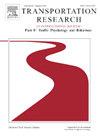Understanding drivers’ situation awareness in highly automated driving using SAGAT, SART, and eye-tracking data
IF 3.5
2区 工程技术
Q1 PSYCHOLOGY, APPLIED
Transportation Research Part F-Traffic Psychology and Behaviour
Pub Date : 2025-02-01
DOI:10.1016/j.trf.2025.02.003
引用次数: 0
Abstract
Rapid and accurately forming situation awareness (SA) is essential when transitioning from autonomous to manual driving. This study examines how drivers’ SA is developed when a takeover request (TOR) is issued and compares SA levels across different environmental and time conditions. A laboratory experiment with 39 participants was performed to analyze the SA, perceived safety, and gaze behavior with different levels of traffic density (high and low), road type (urban and highway), and time budget factor (3 s, 10 s, free). The free time budget factor was determined by assessing the participants’ response times indicating when they perceived having acquired sufficient SA. The results revealed significant effects of traffic density, road type, and time budget on the Situation Awareness Global Assessment Technique (SAGAT), Situational Awareness Rating Technique (SART), and perceived safety. Post-hoc results for time budget factors revealed significant differences based on the SAGAT score, with the 10-second condition exhibiting the highest score. For the SART and perceived safety scores, the 3-second condition was significantly lower whereas no significant difference was observed between the free and 10-second conditions and the mean response time for the free condition ranged from 10–13 s, with the longest duration in high-traffic and urban conditions. Participants gazed at different AOI when provided with a longer lead time whereas in short lead time conditions, their gaze primarily focused on the front window. These results suggest that drivers develop SA differently based on time constraints, and environmental factors. This study provides valuable insights for developing and implementing autonomous systems, contributing to safer and more efficient transitions between automated and manual driving modes.
求助全文
约1分钟内获得全文
求助全文
来源期刊
CiteScore
7.60
自引率
14.60%
发文量
239
审稿时长
71 days
期刊介绍:
Transportation Research Part F: Traffic Psychology and Behaviour focuses on the behavioural and psychological aspects of traffic and transport. The aim of the journal is to enhance theory development, improve the quality of empirical studies and to stimulate the application of research findings in practice. TRF provides a focus and a means of communication for the considerable amount of research activities that are now being carried out in this field. The journal provides a forum for transportation researchers, psychologists, ergonomists, engineers and policy-makers with an interest in traffic and transport psychology.

 求助内容:
求助内容: 应助结果提醒方式:
应助结果提醒方式:


